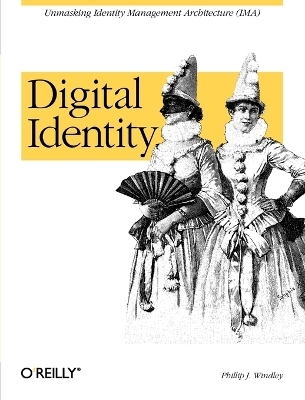
Digital Identity
O'Reilly Media (Verlag)
978-0-596-00878-9 (ISBN)
- Titel nicht im Sortiment
- Artikel merken
The rise of network-based, automated services in the past decade has definitely changed the way businesses operate, but not always for the better. Offering services, conducting transactions and moving data on the Web opens new opportunities, but many CTOs and CIOs are more concerned with the risks. Like the rulers of medieval cities, they've adopted a siege mentality, building walls to keep the bad guys out. It makes for a secure perimeter, but hampers the flow of commerce. Fortunately, some corporations are beginning to rethink how they provide security, so that interactions with customers, employees, partners, and suppliers will be richer and more flexible. Digital Identity explains how to go about it. This book details an important concept known as "identity management architecture" (IMA): a method to provide ample protection while giving good guys access to vital information and systems. In today's service-oriented economy, digital identity is everything.
IMA is a coherent, enterprise-wide set of standards, policies, certifications and management activities that enable companies like yours to manage digital identity effectively--not just as a security check, but as a way to extend services and pinpoint the needs of customers. Author Phil Windley likens IMA to good city planning. Cities define uses and design standards to ensure that buildings and city services are consistent and workable. Within that context, individual buildings--or system architectures--function as part of the overall plan. With Windley's experience as VP of product development for Excite@Home.com and CIO of Governor Michael Leavitt's administration in Utah, he provides a rich, real-world view of the concepts, issues, and technologies behind identity management architecture. How does digital identity increase business opportunity? Windley's favorite example is the ATM machine. With ATMs, banks can now offer around-the-clock service, serve more customers simultaneously, and do it in a variety of new locations.
This fascinating book shows CIOs, other IT professionals, product managers, and programmers how security planning can support business goals and opportunities, rather than holding them at bay.
Phillip J. Windley is an Associate Professor of Computer Science at Brigham Young University. Dr. Windley is a nationally recognized expert in using information technology (IT) to add value to the business. Windley received his PhD in Computer Science from the University of California, Davis in 1990. Prior to doing graduate studies, Windley worked for 4 years as a nuclear metallurgist and a member of the technical staff at the Department of Energy's Division of Naval Reactors.
Foreword Preface 1. Introduction Business Opportunity Digital Identity Matters Using Digital Identity The Business Context of Identity Foundational Technologies for Digital Identity Identity Management Architectures 2. Defining Digital Identity The Language of Digital Identity Identity Scenarios in the Physical World Identity, Security, and Privacy Digital Identity Perspectives Identity Powershifts Conclusion 3. Trust What Is Trust? Trust and Evidence Trust and Risk Reputation and Trust Communities Conclusion 4. Privacy and Identity Who's Afraid of RFID? Privacy Pragmatism Privacy Drivers Privacy Audits Privacy Policy Capitalism Anonymity and Pseudonymity Privacy Principles Prerequisites Conclusion 5. The Digital Identity Lifecycle Provisioning Propagating Using Maintaining Deprovisioning Conclusion 6. Integrity, Non-Repudiation, and Confidentiality Integrity Non-Repudiation Confidentiality Conclusion 7. Authentication Authentication and Trust Authentication Systems Authentication System Properties Conclusion 8. Access Control Policy First Authorization Patterns Abstract Authorization Architectures Digital Certificates and Access Control Conclusion 9. Names and Directories Utah.gov: Naming and Directories Naming Directories Aggregating Directory Information Conclusion 10. Digital Rights Management Digital Leakage The DRM Battle Apple iTunes: A Case Study in DRM Features of DRM DRM Reference Architecture Trusted Computing Platforms Specifying Rights Conclusion 11. Interoperability Standards Standards and the Digital Identity Lifecycle Integrity and Non-Repudiation: XML Signature Confidentiality: XML Encryption Authentication and Authorization Assertions Example SAML Use Cases Identity Provisioning Representing and Managing Authorization Policies Conclusion 12. Federating Identity Centralized Versus Federated Identity The Mirage of Centralized Efficiency Network Effects and Digital Identity Management Federation in the Credit Card Industry Benefits of Federated Identity Digital Identity Standards Three Federation Patterns Conclusion 13. An Architecture for Digital Identity Identity Management Architecture The Benefits of an Identity Management Architecture Success Factors Roadblocks Identity Management Architecture Components Conclusion 14. Governance and Business Modeling IMA Lifecycle IMA Governance Model Initial Steps Creating a Vision IMA Governing Roles Resources What to Outsource Understanding the Business Context Business Function Matrix IMA Principles Conclusion 15. Identity Maturity Models and Process Architectures Maturity Levels The Maturity Model The Rights Steps at the Right Time Finding Identity Processes Evaluating Processes A Practical Action Plan Filling the Gaps with Best Practices Conclusion 16. Identity Data Architectures Build a Data Architecture Processes Link Identities Data Categorization Identity Data Structure and Metadata Exchanging Identity Data Principles for Identity Data Conclusion 17. Interoperability Frameworks for Identity Principles of a Good IF Contents of an Identity IF Example Interoperability Framework A Word of Warning Conclusion 18. Identity Policies The Policy Stack Attributes of a Good Identity Policy Determining Policy Needs Writing Identity Policies An Identity Policy Suite Assessing Identity Policies Enforcement Procedures Conclusion 19. Identity Management Reference Architectures Reference Architectures Benefits and Pitfalls Reference Architecture Best Practices Using a Reference Architecture Components of a Reference Architecture Technical Position Statements Consolidated Infrastructure Blueprint System Reference Architectures Conclusion 20. Building an Identity Management Architecture Scoping the Process Which Projects Are Enterprise Projects? Sequencing the IMA Effort A Piece at a Time Conclusion: Dispelling IMA Myths Index
| Erscheint lt. Verlag | 6.9.2005 |
|---|---|
| Reihe/Serie | O'Reilly Ser. |
| Verlagsort | Sebastopol |
| Sprache | englisch |
| Einbandart | Paperback |
| Themenwelt | Informatik ► Theorie / Studium ► Kryptologie |
| ISBN-10 | 0-596-00878-3 / 0596008783 |
| ISBN-13 | 978-0-596-00878-9 / 9780596008789 |
| Zustand | Neuware |
| Haben Sie eine Frage zum Produkt? |
aus dem Bereich


